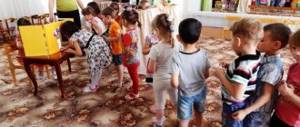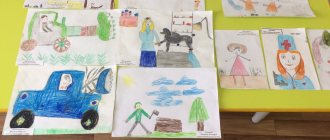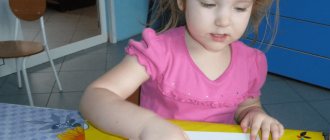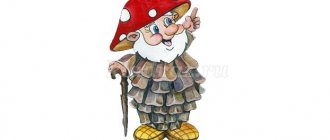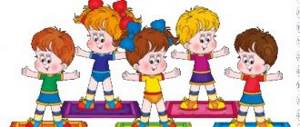What is theater week in preschool educational institutions and its tasks
One of the most accessible forms of art in kindergarten is theater. Children get involved in the game and try on roles. The main goal of the thematic week is the moral education of preschool children, the formation of personal qualities and cultural values.
Event in kindergarten
Theater Week Objectives:
- Introducing children to theater as one of the most popular forms of art.
- The emergence of interest in theatrical activities.
- Development of abilities for creativity and imagination.
- Cultivating a sense of beauty and a desire to bring something good into the world.
- Speech development.
When a theater week is held, the senior group of the kindergarten first rehearses their roles and then plays them on stage in front of their parents. The guys must understand and realize that theater is not a circus, but a completely different form of art, deeper and more subtle.
Theater week calendar and thematic planning (senior group) on the topic
Long-term plan for the thematic week “Theater for Preschoolers”
Senior group No. 2
Goal: Development of children's abilities through theatrical art
Objectives: To create conditions for the development of creative activity of children participating in theatrical activities.
To improve children's artistic skills in terms of experiencing and embodying the image, as well as their performing skills.
Teach children the elements of artistic and figurative means of expression (intonation, facial expressions, pantomime).
Activate children's vocabulary, improve the sound culture of speech, intonation structure, and dialogic speech.
To develop experience in social behavior skills and create conditions for the development of children’s creative activity.
Introduce children to various types of theater (puppet, musical, children's, animal theater, etc.).
To develop children's interest in theatrical play activities.
Work with parents:• Visual propaganda about holding a theater week in a preschool educational institution.
• Conversations with parents on the topic of the week.
• Organization and holding of joint events:
-participation in enriching the gaming environment in groups;
-participation in the design of the photo exhibition “We are in the theater”;
• Visual information “The importance of theatrical activities in a child’s life”
Approximate long-term plan for holding a theater week for preschoolers
Day one “We came to the theater”
Morning.
1. Introduction to the concept of theater: (showing slides, paintings, photographs). Types of theaters (musical, puppet, dramatic, animal theater, etc.).
Purpose: to give children an idea of the theater; expand knowledge of theater as an art form; introduce types of theaters; cultivate an emotionally positive attitude towards the theater.
2. Introducing children to fairy-tale characters. Goal: developing interest in theatrical activities.
3. Theme. Introduction to theatrical professions (artist, make-up artist, hairdresser, musician, decorator, costume designer, actor).
Goal: to form children’s ideas about theatrical professions; to intensify interest in theatrical art; Expand words knowledge.
4. Display of illustrations and photographs of Moscow theaters. Goal: to introduce children to the structure of the theater building, to draw attention to the originality of the architecture and the beautiful facade. with different types of theaters.
Joint educational
activity
1. Teachers plan: conversation games, reading fairy tales with theater shows. For example:
• “Visiting a fairy tale”, “Hello fairy tale heroes”;
• “What did I see? "(from children’s personal experience of visiting the theater)
2. Hood. creativity “My favorite hero” Purpose: To teach to convey the image of a favorite character in a drawing.
Afternoon
1. Plot-role-playing game “We came to the theater.”
Purpose: to introduce the rules of behavior in the theater; arouse interest and desire to play (play the role of “cashier”, “ticketer”, “spectator”); cultivate friendly relationships.
2. Conversations about the rules of conduct in the theater, give the concept of the proverb “Spectator culture”.
Goal: To give children an idea of the rules of conduct in public places; to form a personal attitude towards non-compliance and violation of rules.
3. Theater show (at the teacher’s choice). Goal: to awaken an emotional response in children to watching a fairy tale.
Work with parents: Design of an information stand (moving folder) “Theater and children.” Conversations with parents on the topic of the week.
Day three “Doll-artists”
Morning.
1. Acquaintance with the types of theaters for children (tabletop, bibabo puppet theater, puppets). Goal: to introduce children to different types of theaters; deepen interest in theatrical games; enrich your vocabulary.
2. Looking at bi-ba-bo dolls with children. A conversation about how to use dolls correctly, what
is a tool for driving bi-ba-bo dolls.
3. Reading a Russian folk tale (according to the age of the children)
4. Showing a read fairy tale using bi-ba-bo toys (at the teacher’s choice).
- ml. and Wed - demonstration by the teacher;
- seniors and preg. - demonstration by children.
S.O.D.
Communication
— “Dolls-toys and dolls-artists” (conversation with children according to the teacher’s plan)
— “Funny writings.”
A retelling of one of the familiar fairy tales using elements of puppet theater.
Goal: Encourage children to compose simple stories with characters from familiar works. Cultivate a sense of humor and help improve children's self-esteem. Develop children's coherent speech.
Afternoon
1. Theatrical puppet show. Goal: To develop children's interest in performing arts.
2. Psycho-gymnastics. "Different faces."
Goal: Encourage children to experiment with their appearance (facial expressions, gestures). Develop children's ability to switch from one image to another.
3. “Introduction to puppets.” Goal: Improve puppeteering techniques, consolidate knowledge about the rules of manipulating theatrical puppets.
4. Independent activity of children in the theater corner. Sketches with tabletop dolls based on well-known Russian folk tales. Goal: Improve puppeteering techniques, consolidate knowledge about the rules for manipulating theatrical puppets of different systems
Working with parents:
consultation for parents: “So that the fairy tale does not become boring...”. Recommendations for parents on choosing fiction for children
Day two “Our hands are not for boredom”
Morning.
1. Introducing children to finger theatre, mitten theatre, shadow theater. Goal: to give children an idea about the features of this type of theater.
2. Finger gymnastics “Bird”, “Owl” and others. Goal: speech development, development of intelligence, spatial thinking, creative abilities of children.
3. Work with one of the types of theaters:
- examination of characters;
- dialogues: wolf - fox, wolf - bear, mouse - wolf.
Goal: To develop the ability to build dialogues between characters in imaginary circumstances. Develop children's coherent speech and expand their figurative speech. Monitor the expressiveness of the image.
4. Game “Create a funny and sad dialogue between the Mouse and the Bunny.” Goal: Develop communication skills; diversify intonation expressiveness; pay special attention to children's diction.
S.O.D.
1. Artistic creativity:
making toys - homemade origami fairy tales. Goal: To develop children’s ability to independently create characters for a fairy tale. Cultivate accuracy in working with paper. Develop memory, attention, creativity and imagination.
Collective application “There is a tower in the field.” Goal: to improve children’s ability to cut circles from squares of different sizes, develop fine motor skills of their fingers, and develop creativity; compose a composition; supplement with various elements.
Collective application “Kolobok”. Goal: to improve children’s ability to glue ready-made forms; develop creativity; create an overall composition.
Afternoon
1. Children's games with sounding instruments. Goal: to give children an idea of the musical design of performances.
2. An evening of riddles based on the works “The Tale of the Fisherman and the Fish”, “Little Red Riding Hood”, “The Tsokotukha Fly”, “Fedorino’s Mountain”, “Kolobok”, “Teremok”, “Turnip”. Target:
3. Game “Try it yourself.” Finger theater “Ryaba Hen” (at the teacher’s choice). Goal: to develop children’s ability to use finger theater in free activities; distribute characters; convey the characteristic features of the heroes of the fairy tale.
4. S/r game “A trip to the puppet theater”. Purpose: To acquaint children with the structure of the theater building, to draw attention to the originality of the architecture and the beautiful facade. Enrich children's vocabulary.
Work with parents: Invite parents to get acquainted with the posters of Moscow theaters whose repertoire includes children's performances.
Day four “We are artists”
Morning.
1. Exercise “Tell the poems of A. Barto using gestures and facial expressions.” Goal: Learn to convey images of characters using expressive plastic movements. Develop creativity, imagination and imagination.
2. Psycho-gymnastics. Goal: Learn to use intonations, pronouncing phrases sad, happy, angry, surprised. Learn to build dialogues by choosing your own partner. Cultivate endurance, patience, and complicity.
- “Sad and cheerful puppy” (based on the fairy tale by N. Suteev “Who said meow?”);
— “Phrase in a circle”
3. Games “Pass the pose”, “We won’t tell you what we did.”
Goal: To develop resourcefulness, imagination, fantasy. Cultivate goodwill.
Prepare children for actions with imaginary objects.
S. O. D. Improvisation based on Russian folk tales.
Work on staging fairy tales.
Actor's workshop.
Goal: To develop children’s ability to independently make attributes for a fairy tale. Cultivate accuracy when working with fabric and cardboard. Develop memory, attention, creativity and imagination.
Drawing a poster for the upcoming soap bubble show. Involve children in artistic activities.
Afternoon
1. Work on the album “All about the theater”.
Goal: To teach children to generalize their experience and share their impressions of new knowledge. Develop aesthetic taste in album design (joint work of children and parents).
2. S/r game “We are artists” (production of a fairy tale well known to children). Purpose: To acquaint children with the scenario (direction) of a fairy tale. Teach children to express their opinion about a fairy tale in a new way. Complete the tale with the necessary episodes. Cultivate the ability to listen to the opinions of others, develop endurance and patience.
3. Games based on the fairy tales “By the Bear in the Forest”, “Geese-Geese”, “Sly Fox”, “The Little Gray Bunny Is Sitting”.
4. S/r game “Visiting the Three Bears.” Encourage children to creatively interpret well-known stories using role-playing games, dramatization games and improvisation
Work with parents: Introduce parents to the theater playbill - the repertoire of Moscow theaters for preschool children. All groups
Day five “Theater and music”
Morning.
1. Introduction to musical theaters. Purpose: To give an idea of the various genres of musical theater, such as “opera”, “ballet”, “musical”, “musical fairy tale”.
2. Acquaintance with the musical design of performances. Examination and playing of musical and noise instruments in order to teach children the sound design of scenes from fairy tales.
3. Rhythmoplasty. Musical composition: “Carnival of Animals”, “Trip to the Zoo”. Goal: Develop children's motor abilities; agility, flexibility, mobility. Teach evenly, move around the site without bumping into each other.
4. Musical folk and round dance games according to the age of the children. Goal: Encourage children to actively participate in games.
S.O.D. Music
Watching excerpts from the musical films “Mama” (based on the fairy tale “The Wolf and the Seven Little Goats”, the ballet “The Nutcracker”, the musical “The Little Mermaid”, the opera “The Snow Maiden”, etc.
Looking at photographs of the opera house, illustrations for the opera “The Snow Maiden”
(to the ballet “The Nutcracker”)
Listening to recordings of musical fairy tales according to the age of children.
Goal: introducing children to the world of musical art.
Afternoon
1. Rhythmoplasty. Sketches for movement: “The Fox is Coming”, “Tasty Jam”, “Dance of the Animals”.
Goal: To develop children's ability to use gestures.
2. Game technique “Guess who it is? " Goal: to identify a character from a fairy tale based on the nature of the music.
3. Voice-over of a fairy tale chosen by the children using noise instruments. Encourage children to creatively interpret famous stories using noise instruments.
4. Travel game “In the world of music and dance.” Goal: To improve the comprehensive development of children’s creative abilities through theatrical art
5. Musical show - performance with soap bubbles. Goal: create a joyful and cheerful mood; encourage children to become active participants in the performance; learn to convey the impressions received vividly and emotionally.
Work with parents: Invite parents, together with their children, to convey their impressions received during the theater week through visual activities.
Planning a theater week for junior, senior and preparatory groups
Thematic week at the preschool educational institution “Theater in the senior group” is held only after careful preparation. Junior kindergarten starts rehearsals early. The teacher must make sure that all the guys are ready to go on stage.
Theater week
Preparation is also required for the lead teacher, who will meet guests and children on stage and set them in the right mood, as well as support them during the production.
Determining the topic
Before planning a theater week, you need to determine its theme. According to the Federal State Educational Standard, there is a recommendation for different groups of a preschool institution:
- junior groups: “We Lived at Granny’s”, “Turnip”, “Kolobok”, “Teremok”, “Masha and the Bear”;
- middle groups: “The Three Little Pigs”, “Cat’s House”;
- preparatory groups: “Geese-swans”, “Turnip”, “Wolf and seven kids”.
Each child participating in the production is given a speech a month before the performance, which he must memorize and rehearse several times.
Important! The theme is determined based not only on the complexity, but also on the duration of the tale. A performance in a kindergarten cannot last longer than 20 minutes, otherwise the children will get confused and tired. The optimal time is 10 minutes in the younger group, 15-20 minutes in the preparatory group.
How to teach a child to count - effective and proven methods
Organization of classes
A week before the performance, a theater week begins at the preschool educational institution, each day of which is dedicated to one topic and the development of the child.
Lesson plan for the creative week:
- Monday: introductory conversation with viewing of “Theater” paintings, role-playing story game and group exercises for the development of mobility with elements of production;
- Tuesday: the teacher talks about how to behave when attending a performance, then the kindergarteners participate in a game-situation where they must find a way out of one small problem, posters and invitation cards are made for the production, which will take place at the end of the week, can also be arranged drawing pictures on the theme of the week;
- Wednesday: teacher’s story about how a tabletop puppet theater was created, didactic game and reading of special literature “At a school matinee” by Agnia Barto;
- Thursday: children look at a huge encyclopedia on the world of circus, learn how acts are staged, listen to the teacher's story about Yuri Nikulin, and then play a small production of “Geese and Swans”. At the end of the day, the children visit a small theater and watch a performance;
- Friday: a conversation is held during which the teacher learns from the children what they were able to learn about the theater and whether they are interested in such activities. To prepare, the participants play a role-playing game and then show their performance on the kindergarten stage.
Preparing for the event
Additional Information! Children must participate in preparing the scenery and costumes for the holiday; this allows them to feel the atmosphere of the theater and expect the performance without fear, but with great interest.
Distribution of roles
In the process of preparing for the matinee, the teacher assigns roles to all the children in the group, but this is not an easy task. It is extremely important to highlight everyone and not offend anyone.
Most often, they do the following: children with a good, loud voice and clear speech read texts and poems, and those who are not so artistic get a place in the “extras,” for example, in a dance group.
It is important that everyone takes part in the production, but at the same time there is a division into main and secondary roles. In order for the kids to have time to rehearse their performance, they need to start preparing a month before the performance.
Methods of teaching reading to preschool children
Planning a theater week (senior group)
Alesya Chistova
Planning a theater week (senior group)
Theater Week
Group No. 5. “School No. 2115” SP5
Tasks:
— creating conditions for the development of children’s creative activity (equipping the room, preparing attributes, costumes,
music and lighting design);
- introducing children to theatrical culture (types of theatrical art, features of theatrical art, theater from the outside and from the inside,
viewer culture);
— development of speech: diction, speech breathing; developing in children an attitude towards clear and concise speech as the basis for successful communication;
training in the ability to conduct dialogue and monologue;
- development of children’s thinking abilities, imagination, fantasy, perception, attention (drawing up a logical chain
works, the ability to improvise, draw conclusions, defend one’s point of view);
— development of verbal and non-verbal forms of communication (mastering expressive movements and intonations, the ability to listen to the interlocutor);
— development of the emotional sphere (sympathy, empathy, development of the ability to correctly express one’s feelings)
— development of sustainable interest in theatrical activities.
Topics Contents of work Forms
Monday.
"We came to the theater"
The first half of the day.
1. Introduction to the concept of theater: (showing slides, paintings, photographs). Types of theaters (musical, puppet, dramatic, etc.).
Purpose: to give children an idea of the theater; expand knowledge of theater as an art form; introduce types of theaters; cultivate an emotionally positive attitude towards the theater.
2 Introduction to theatrical professions (artist, make-up artist, hairdresser, musician, decorator, costume designer, actor).
Goal: to form children’s ideas about theatrical professions; to intensify interest in theatrical art; Expand words knowledge.
3. Display of illustrations and photographs of Moscow theaters.
Goal: to introduce children to the structure of the theater building, to draw attention to the originality of the architecture and the beautiful facade of different types of theater.
Afternoon
1. Plot-role-playing game “We came to the theater.”
Purpose: to introduce the rules of behavior in the theater; arouse interest and desire to play (play the role of “cashier”, “ticketer”, “spectator”); cultivate friendly relationships.
2. Conversations about the rules of conduct in the theater, give the concept of the proverb “Spectator culture”.
Goal: To give children an idea of the rules of conduct in public places; to form a personal attitude towards non-compliance and violation of rules.
Working with parents:
Design of an information stand (moving folder) “Theater and Children”. Conversations with parents on the topic of the week.
Tuesday.
Morning
Solving riddles about the theater.
Goal: to teach children to recognize by description various concepts of the topic (Buffoons, director, dialogue, makeup, puppeteer, poster, scenery, wig, etc.), to activate them in speech and clarify them. Develop logical thinking, maintain interest in the topic being studied.
The first half of the day.
1. Acquaintance with the types of theaters for children (tabletop, bibabo puppet theater, puppets).
Goal: to introduce children to different types of theaters; deepen interest in theatrical games; enrich your vocabulary.
2. Looking at bi-ba-bo dolls with children.
A conversation about how to use dolls correctly and an educational story “The history of the appearance of bi-ba-bo dolls.”
"Funny essays."
A retelling of one of the familiar fairy tales using elements of puppet theater.
Goal: Encourage children to compose simple stories with characters from familiar works. Cultivate a sense of humor and help improve children's self-esteem. Develop children's coherent speech.
Afternoon
1. Theatrical puppet show.
Goal: To develop children's interest in performing arts.
2. Psycho-gymnastics “Different faces”.
Goal: Encourage children to experiment with their appearance (facial expressions, gestures). Develop children's ability to switch from one image to another.
3. Independent activity of children in the theater corner. Sketches with tabletop dolls based on well-known Russian folk tales.
Goal: improve puppeteering techniques, consolidate knowledge about the rules for manipulating theatrical puppets of different systems
Working with parents:
Recommendations for parents on choosing fiction for children.
Wednesday.
The first half of the day.
1. Introducing children to finger theater, mask theater, shadow theater.
Goal: to give children an idea about the features of this type of theater.
2. Finger gymnastics “Bird”, “Owl” and others.
Goal: speech development, development of intelligence, spatial thinking, creative abilities of children.
3. Work with one of the types of theaters:
- examination of characters;
- dialogues: wolf - fox, wolf - bear, mouse - wolf.
Goal: To develop the ability to build dialogues between characters in imaginary circumstances. Develop children's coherent speech and expand their figurative speech. Monitor the expressiveness of the image.
4. Game “Create a funny and sad dialogue between the Mouse and the Bunny.”
Goal: Develop communication skills; diversify intonation expressiveness; pay special attention to children's diction.
Walk.
Quiz, simulation exercises “Fairy-tale characters”.
Goal: to teach children to recognize the characters of familiar fairy tales by description, by excerpts of the work, to portray the heroes of fairy tales. Develop logical thinking and artistic abilities.
Afternoon.
Game "Try it yourself." Finger theater "Straw bull" (at the teacher's choice). Goal: to develop children’s ability to use finger theater in free activity; distribute characters; convey the characteristic features of the heroes of the fairy tale.
Children's games with sounding instruments.
Goal: to give children an idea of the musical design of performances.
S/r game “A trip to the puppet theater”.
Purpose: To acquaint children with the structure of the theater building, to draw attention to the originality of the architecture and the beautiful facade. Enrich children's vocabulary.
Work with parents: invite parents to get acquainted with the posters of Moscow theaters whose repertoire includes children's performances.
Thursday.
The first half of the day
1. Game exercise “Pierrot and Harlequin”.
Goal: to teach children to perform morning exercises, acting in the form of various characters, to change the nature of movements, their dynamics in accordance with the task.
Enrich the motor, communicative and social experience of children.
2. “We are artists!” Conversation with children about theater actors’ costumes, makeup, etc.
What role would you like to play?
Goal: to consolidate knowledge about the theatrical life of actors behind the scenes, to develop creative imagination in children
3. Reading the poem by A. Barto “In the Theater.”
4. "Acquaintance with puppets."
Goal: Improve puppeteering techniques, consolidate knowledge about the rules of manipulating theatrical puppets.
Afternoon.
S/r game “We are artists” (production of a fairy tale well known to children).
Purpose: To acquaint children with the scenario (direction) of a fairy tale. Teach children to express their opinion about a fairy tale in a new way. Complete the tale with the necessary episodes. Cultivate the ability to listen to the opinions of others, develop endurance and patience.
Walk.
Games based on the fairy tales “By the Bear in the Forest”, “Geese-Geese”, “The Sly Fox”, “The Little Gray Bunny Is Sitting”.
Work with parents: introduce parents to various types of theatrical games, principles and techniques of their organization, developmental and educational opportunities.
Friday.
The first half of the day.
1. Introduction to musical theaters.
Purpose: To give an idea of the various genres of musical theater, such as “opera”, “ballet”, “musical”, “musical fairy tale”.
2. Acquaintance with the musical design of performances. Examination and playing of musical and noise instruments in order to teach children the sound design of scenes from fairy tales.
3. Psycho-gymnastics.
Goal: Learn to use intonations, pronouncing phrases sad, happy, angry,
surprised. Learn to build dialogues by choosing your own partner. Bring up
endurance, patience, complicity.
“Sad and cheerful puppy” (based on the fairy tale by N. Suteev “Who said meow?”); "Phrase in a circle"
Afternoon.
1. Game technique “Guess who it is?”
Goal: to identify a character from a fairy tale based on the nature of the music.
2. Voice-over of a fairy tale chosen by the children using noise instruments. Encourage
Adding attributes to the musical corner (xylophone, whistles, pipes, tambourines, etc.) Images of a ballet production, opera, musical. Disc with children's songs for
improvisation.
Working with parents:
invite parents, together with their children, to convey their impressions received during the theater week through visual activities.
Final speech
Every parent can come to the preschool educational institution and support their child. The theatrical show is held at the end of the week, when the children have learned a lot about this field of art and are well prepared for their performance.
Progress of the final presentation:
- The teacher comes on stage and begins the performance, pronouncing introductory words. His task is to become a support for children and calm those who are nervous, suggest words and monitor the progress of the production.
- Children go on stage in costumes and play their roles. There must be musical accompaniment, and, if possible, lighting.
- Gifts may be distributed at the end of the event if parents have arranged for them in advance. All participants come onto the stage and bow to the audience.
Following the performance, a conversation is held with preschoolers, where they share their impressions and tell whether they liked being on stage. The teacher’s task is not to point out mistakes, but to praise each child for his success in the event.
Staging at the end of the week
Important! To avoid mistakes and inconsistencies, you need to prepare in advance a complete calendar plan according to which the theater week will be held.
